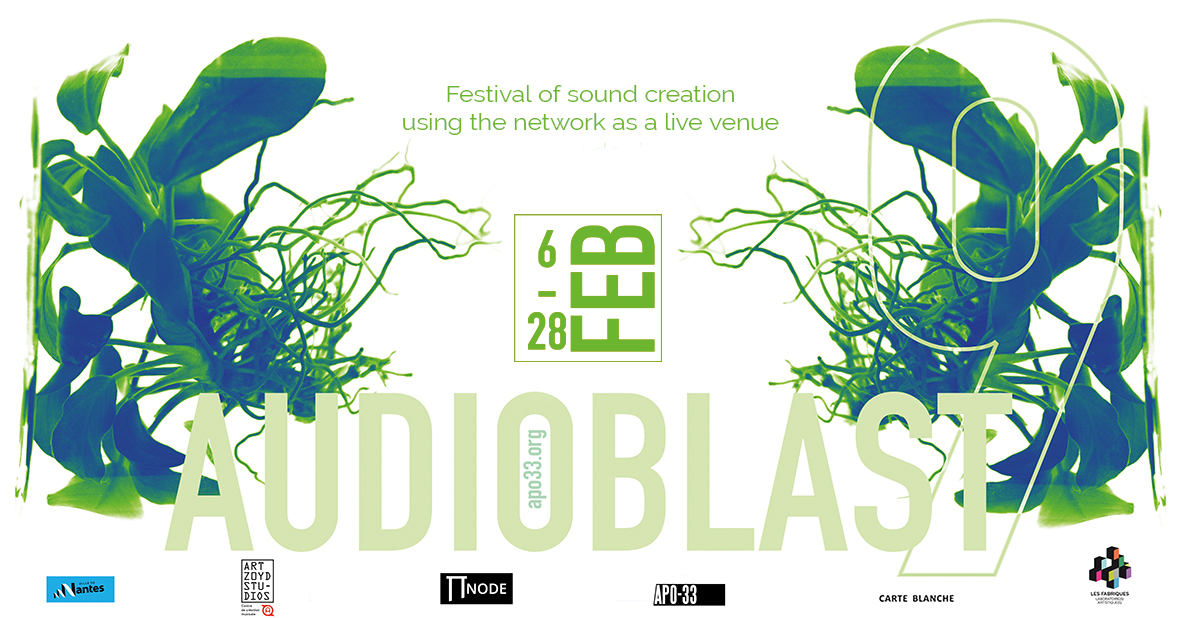• From Friday 26 to Sunday 28 February •
https://www.twitch.tv/asso_apo33
http://p-node.org
Facebook Live
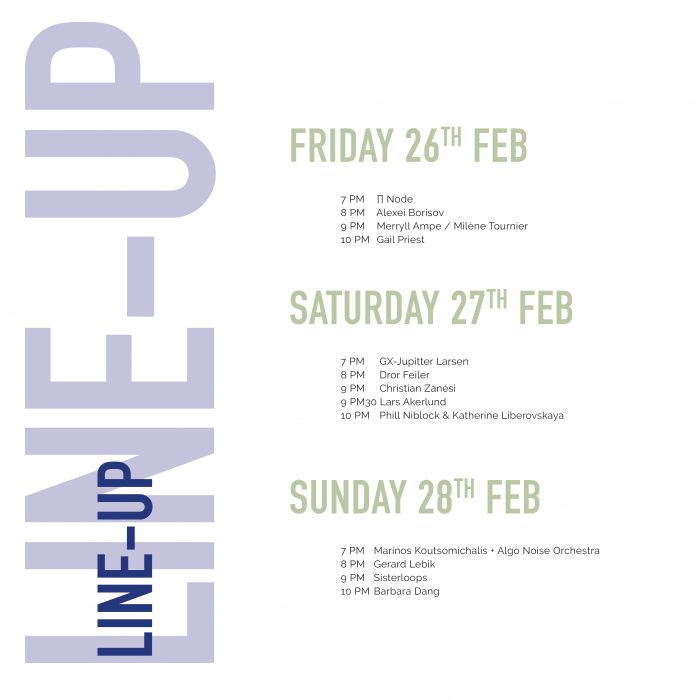
Festival of sound creation using the network as a live venue, Audioblast broadcasts numerous networked audio practices including; experimental music, drone, noise, field recordings, sound poetry, electronic and contemporary music.
Audioblast Festival is in its ninth year having began life in 2012 as the only “Live” experimental sound festival using the network as its primary venue.
The adventure has seen hundreds of artists and musicians experiment with the online format and networked live performances over the years. Practices as diverse as radio art to live coding, improvisation to sound poetry and everything else in between.
Restrictions of movement and closure of cultural venues across the globe, caused by the Covid-19 pandemic, has resulted in a surge in Live online performances these previous 12 months.
Leading many more artists by necessity to discover the tools for live performance, experimenting with performance formats and connecting with their audiences and communities through the wires.
Online but also on site : Plateforme Intermédia & Ateliers de Bitche
Co-production Apo33 and Art Zoyd Studios.
Curation: Kasper T Toeplitz & Julien Ottavi.Curation : Kasper T Toeplitz & Julien Ottavi.
https://fb.me/e/5M2xys4K4
LINE UP :
Phill Niblock & Katherine Liberovskaya
Meryll Ampe / Milène Tournier
Marinos Koutsomichalis
Algo Noise Orchestra
GX-Jupitter Larsen
Christian Zanési
Lars Akerlund
Alexei Borisov
Barbara Dang
Gerard Lebik
Sisterloops
Dror Feiler
Gail Priest
Π Node
Prog :
FRIDAY 26TH fEB
7 PM Π Node
8 PM Alexei Borisov
9 PM Merryll Ampe / Milène Tournier
10 PM Gail Priest
SATURDAY 27TH fEB
7 PM GX-Jupitter Larsen
8 PM Dror Feiler
9 PM Christian Zanési
9 PM30 Lars Akerlund
10 PM30 Phill Niblock & Katherine Liberovskaya
SUNDAY 28TH fEB
7 PM Marinos Koutsomichalis + Algo Noise Orchestra
8 PM Gerard Lebik
9 PM Sisterloops
10 PM Barbara Dang
This year’s theme is : Divergent Landscapes
Divergent Landscapes
“The physical and environmental attributes of landscapes often shape patterns of population connectivity”
This years Audioblast festival explores the theme of Divergent Landscapes
In the wake of multiple lock-downs, transforming city centers into wildlife friendly zones whilst simultaneously separating urban populations from accessing nature, our experiences of landscape has become mediated, hybrid, multiple and connected. Whether strolling on picturesque beaches in popular video-games, designing virtual realty utopias online or listening to the intensity of birdsong in a soundscape otherwise saturated by the drones of engines ferrying children to school or people to work, we have come to depend on our connected devices to navigate our isolation from each other, from nature and from culture.
Divergent Landscapes seeks to highlight this dichotomy of our virtual wildernesses, hybrid journeys, streams of resistance, phantasmagoric forests and a networked embrace. Making visible the Divergent Landscapes, through our sonic identities, digital realities and public/private (exterior /interior) spaces.
As part of the festival : Audioblast exhibition
• Phill Niblock & Katherine Liberovskaya •
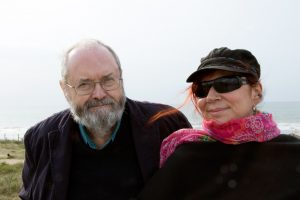
📸 Anne Wellmer
◼️ Phill Niblock is an artist whose fifty-year career spans minimalist and experimental music, film and photography. Since 1985, he has served as director of Experimental Intermedia, a foundation for avant-garde music based in New York with a branch in Ghent, and curator of the foundation’s record label XI. Known for his thick, loud drones of music, Niblock’s signature sound is filled with microtones of instrumental timbres that generate many other tones in the performance space.
◼️ Katherine Liberovskaya is a video and media artist based in Montreal, Canada, and New York City. She has been working predominantly in experimental video since the late eighties. Over the years, she has produced many single-channel videos, video installation works and video performances which have been presented at a wide variety of artistic venues and events around the world.
Performance :
A set alternating between parts featuring Katherine Liberovskaya performing live visuals to Phill Niblock mixing field recordings and a section with pre-recorded composition and video by Niblock accompanied by live musicians
– part 1:
Katherine Liberovskaya (live visuals with live cameras; and maybe live toy automatons and sound) with Phill Niblock (field recordings)
– part 2:
Music by Phill Niblock “Noizzze” (2020, 23 min) [recorded samples by I R E :Kasper Toeplitz, bass; Franck Vigroux, guitar; Helene Brischand, harp]
Video by Phill Niblock “32 Waves” (2018)
joined live by Kasper Toeplitz and Julien Ottavi on modified basses
– part 3:
Katherine Liberovskaya (Visual Foley: live visuals via live cameras and materials) with Phill Niblock (field recordings)
http://phillniblock.com/
http://www.experimentalintermedia.org/![]()
• Méryll Ampe / Milène Tournier •


Duo performance formed as part of the Bruit de Surface residency of the Literature and Music collection:
Art Zoyd Studios imagined to explore other interactions of music with the world around us – namely its possible links and connivance with literature – and to place this research in another place, the space of the internet. From this is born the series or collection “Bruit de surface”, meetings between writers and musicians, meeting in pairs, to try to create hybrid works, between text, performance and concert, between the meaning of the word and the abstraction of sound.
◼️ A sound artist and sculptor by training, Meryll Ampe establishes links between these two practices. She conceives sound as a medium to be sculpted in real time using acoustic elements captured in her daily life as well as recorded sound sources to combine them with synthesizers, cassette players, cymbals, etc… All this to question an implacably dense sound material that evolves underground and in relief. Creating different strata live and playing with the interweaving of volumes, planes and perspectives, Méryll Ampe likes to graze the limits of sound and digs into its flesh with a permanent interest in roughness, porosity, mass-density and the unexpected.
Live, she engages in a powerful instinctive and radical way, using the listening of the place and the body as a barometer and thus weaving formidable massive states and sound entities that unfold, cross, mix or decompose for a thunderous result of sound bursts of both abstract-black and rhythmic-saturated sounds.
◼️ Milène Tournier, born in 1988, doctor in theater studies at the Sorbonne Nouvelle (Figures de l’impudeur: dire, écrire, jouer l’intime 1970-2016), is an author of theater, poetry and crossed forms. She publishes in 2018 Et puis le roulis (Ed Théâtrales); in 2019 Nuits (La Ptite Hélène). Her collection of poetry Poèmes d’époque (ed. Polder), prefaced by François Bon, would like to capture the urbanity between fulgurances and temptation of “everything”. Her second collection L’autre jour (fall 2020, Lurlure) continues this double quest of writing about the city and the intimate. She produces filmic writings that she shares on Youtube. In 2019-2020, she will participate in the Ile-de-France region’s author residency program. She is also a teacher librarian in a high school.
Project :
“Méryll and Milène will propose a live incantation to the city. How to call to oneself, voice, text and music mixed together, an absent and dreamed city, like raising a mirage?”
Milaine :
Méryll :
meryllampe.com
bandcamp de Méryll
• Marinos Koutsomichalis •

Marinos Koutsomichalis is a media artist, scholar and creative technologist. He was born in Athens, GR (1981) and has since lived and worked in various cities around the world. His practice is hybrid, nomadic, and ethnographic, involving field-work, creative coding, critical theory, making, lecturing, live performance, workshopping, artist/research residencies, ‘Doing-It-With-Others’, and hands-on experimentation with materials and technologies of all sorts. His artistic corpus is prolific, yet persistently revolving around the same few themes: material inquiry/exploration; self-erasure; the quest for post-selfhood. He has hitherto publicly presented his work, pursued projects, led workshops, and held talks worldwide more than 250 times and in all sorts of milieux: from leading museums, acclaimed biennales, and concert halls, to churches, industrial sites, and underground venues. He has held teaching and research positions in various academic institutions, has published a book and numerous academic/scientific articles, and is currently a Lecturer in Multimedia Design for Arts at the Cyprus University of Technology (Limassol, CY) where he co-directs the Media Arts and Design Research Lab.
In/Ex-terior (Ir)rationalities :
In the wake of multiple lock-downs and extraordinary political manoeuvring affecting everyday life globally, this project inquires the possibility of a (post-)pandemic distributed utopia—the possibility of a new hybrid public/private space wherein fragmented aspects of the everyday are juxtaposed and orchestrated in ever-creative fashions. Individuals compose and selectively live-stream local (ir)rationalities concerning their immediate surrounings; utilising objects, radio receivers, webcameras, window views, poetry, improvised bedroom noises, their own moving bodies, and other. These streams are further manipulated on the account of a group of performers (issuing arbitrary instructions) and a software automaton running on the server (selectively executing the former instructions). In this fashion, an improvised cybernetic audiovisual landscape emerges—one that is intended as an introspection of the complex dynamics forged at the intersections of local pandemic (ir)rationalities, their improvised and semi-automated manipulation, and a public broadcast thereof.
www.marinoskoutsomichalis.com
https://soundcloud.com/marinos-koutsomichalis
Algo Noise Orchestra
• GX-Jupitter Larsen •

Frequency, excerpt… from GX Jupitter-Larsen on Vimeo.
jupitter-larsen.com
https://gxjl.bandcamp.com/
• Christian Zanési •

📸 Linda Bujoli
Christian Zanési was born in 1952. He is a former student of Guy Maneveau and Marie-Françoise Lacaze (University of Pau, 1974-1975) then of Pierre Schaeffer and Guy Reibel (Paris Conservatory, 1976-1977).
Since joining the Groupe de Recherches Musicales de l’Ina in 1977, he has multiplied experiences, achievements and encounters. He is at the origin of many projects, notably: the electronic PRÉSENCES festival, the program Electromania on France Musique (with David Jisse and Christophe Bourseiller) and the CD boxes dedicated to the historical composers of the GRM.
He was the artistic director of Ina GRM until June 2015.
He has composed many electroacoustic pieces, often given in concert. Since the 2000s, he has also developed a practice of live music. He has played with Christian Fennesz, Rom, Mika Vainio, Edward Perraud, Frederick Galiay, Thierry Balasse, Kasper Toeplitz, David Jisse, Bérangère Maximin, Didier Petit, Phlippe Foch, Maguelone Vidal and Arnaud Rebotini.
Before the blast :
For Audioblast 9, Christian Zanési proposes a new musical performance based on his piece “L’esprit des lieux”. Lasts about 30 minutes.
https://www.youtube.com/channel/UCyiYzS9X4PYq9sdnZk50JyQ/featured
https://soundcloud.com/christianzanesi
• Lars Akerlund •
![]() © Bengt Wanselius
© Bengt Wanselius
Lars Åkerlund is a composer, sound artist and performer of mainly electronic and electro acoustic music. Classically
trained but mainly active in the underground scene, co-founding bands like P.I.T.T. (with Zbigniew Karkowski et al), Lucky People Center (with Johan Söderberg and Sebastian Öberg) and LLLSD.
He studied classical guitar at Conservatorio del Liceo, Barcelona and classical guitar and electro acoustic music at the Royal College of Music, Stockholm, at the EMS, Stockholm as well as musicology at the University of
Stockholm. He composes and performs live with computers, controllers and different live electronic equipment, such as amplified monochord.
Lars Åkerlund released records on labels as Radium 226.05, Firework Edition Records, SubRosa, Monotype Records, R.O.S.A., MNW Records, ZORA and Fylkingen Records.
He works both as a solo artist and in collaborations with other artists. Musical collaborations include Kasper T Toeplitz, Zbigniew Karkowski, CM von Hausswolff, Jean-Louis Huhta, Dror Feiler, Lise-Lotte Norelius, Daniel Rozenhall, Freddie Wadling, Leif Elggren, Kent Tankred, Flesh Quartet, Kroumata, Sebastian Öberg and Johan
Söderberg.
Member of the multi media group
Projet:
His piece is a recorded live electronic performance where digital and analog devices were mixed.
The movie is a comment that not necessarily has anything to do with the sound.
https://soundcloud.com/larsakerlund
https://zkm.de/en/person/lars-akerlund
• Alexei Borisov •
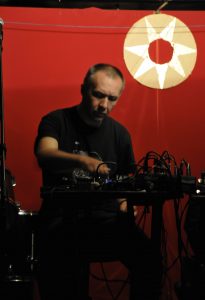
Born in Moscow on December 7, 1960. Borisov graduated from the Moscow State University where he had studied History and Arts. His controversial performing career (as a guitarist) began in the Center new-wave group, in 1980. Next year, he formed the Prospekt mod-band (with Dmitry Matsenov), and re-modeled it in 1985 as the shifting Notchnoi Prospekt with then-partner Ivan Sokolovsky. After the dissolution of the band in the beginning 1990s, he surfaced then in the “noise reconstruction and techno acoustics” duo F.R.U.I.T.S. with Pavel Zhagun (also known as Piezo) and in various art/noise/industrial/improv acts like Joint Committee, Atomic Bisquit Orchestra, New Russian Alternative, Gosplan Trio, Lost Sound and many more. He and his previous associate, the experimental Finnish sound-sculptor and journalist Anton Nikkila, established in 2000 their own N&B Research Digest label. Since 2003 Borisov curates international festival of experimental music “Noise and Fury” at the DOM Cultural Centre in Moscow (www.dom.com.ru). Among his other collaborations are the joint projects with KK Null (Japan), Jandek (USA), Jeffrey Surak (USA), Ilpo Vaisanen (Finland), Kurt Liedwart (Russia), Olga Nosova (as Astma duo) (Russia/Germany), Katya Rekk (Russia), Sergey Letov (Russia), Vlad Makarov (Russia), Sergei Kostyrko (Russia), Ilia Belorukov (Russia), Dave Phillips (Switzerland), Joke Lanz and Jonas Kocher (as Radical Muzak Septet) (Switzerland), Franz Pomassl (Austria), Mia Zabelka (Austria), Thomas Buckner (USA), Benjamin Skepper (Australia), Anton Mobin (France), Jelena Glazova (Latvia), Sergei Kasich (Russia/USA), Igor Levshin (Fake Cats Project) and many more. Borisov also collaborates with different video and multi-media artists, poets, dance companies, performance groups, theaters and film directors. He also works as a DJ in clubs and on different radio stations in Russia and abroad, and contributed as a journalist to some Russian and international web sites, magazines and newspapers. He is portrayed in the 2013 music documentary Elektro Moskva
Performance :
His performance is a live set of diy electronics, tapes and laptop (Audio mulch) (most probably that I will transmit myself from my apartment in Moscow…).
https://alexeiborisov.bandcamp.com/
https://soundcloud.com/alexei-borisov
https://www.mixcloud.com/alexeiborisov/
http://www.elektromoskva.com/english
• Barbara Dang •
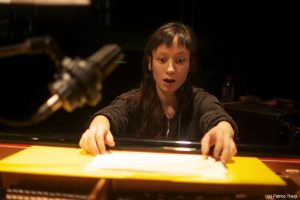
A member of the Muzzix collective, Barbara Dang’s sound universe ranges from written experimental music to improvised music. She works with Olivier Benoit and Jérémie Ternoy then meets other musicians and composers such as Sophie Agnel, Didier Aschour, Radu Malfatti, Michael Pisaro… She develops a repertoire of piano and harpsichord solo (Louis Andriessen, John Cage, Cornelius Cardew, Henry Cowell, Morton Feldman, Tom Johnson, Federico Mompou, Erik Satie…) which brings into play unusual techniques (prepared, amplified piano, indoor playing) where pure musical action is privileged over aestheticised individual expression.
Within small formations or large ensembles (La Pieuvre, Le Grand Orchestre de Muzzix, Dedalus), she explores other instrumentariums such as amplified objects, electronics or organ.
Since March 2015, she has been working for Revue & Corrigée: a reference review of experimental sound practices.
Performance :
The piano is open, the music is sometimes written, sometimes improvised, where metal, wood and stones are heated by hand.
• Gerard Lebik •
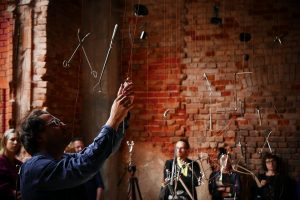
Gerard Lebik is an improviser, sound artist and composer.
Explores heterogeneous sources and research methods on audible and perception phenomenon of sound and music. In research on the nature of sound, he focuses on issues such as the perception and propagation of sound waves, the psychological aspect of binaural sound, the ontological sense of time, and sonic relation in architecture and urban context. Despite the variety of interests, his works focus on the search for perfect forms
of beauty, balancing between expressive and constructive art. The basis of his activity is a creative process, as opposed to an effect, and an experiment that respects the nomos of aesthetic of the ancient Pythagoreans .
In 2007 graduated with Wroclaw Academy of Music. Since 2015 artistic director and curator in Sanatorium Of Sound – festival exploring experimental and new music held in Sokołowsko Poland.
The low of the refraction and an orange glow night after night illuminates the sky of city :
The composition is based on the classic method of FM and AM synthesis and refers to a fragment of the text describing the tangle of certain historical and everyday events, obvious facts, and unconfirmed or falsely disclosed information directed to social media.
… In 984, the Persian mathematician Ibn Sahl سهل ابن العلء سعد أبو ;c. 940–100 discovers the law of refraction describing the change in the direction of a wave passing from one medium to another, which depends on the speed of wave propagation in a given medium.
Returning home, Thomas Harriot thought that he should not explain his concepts to Kepler in such detail.
Suddenly he surprised, it was night. What’s so shining? This is a gigantic investment of Citronex – 43 hectares of
vegetable greenhouses. Why do they turn on the sun at night and why in the west? Studied color prints from modern laser microscopes taking photos of eyeballs tests confirmed that it is no longer possible to correct eyesight…
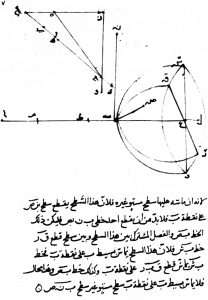
http://gerardlebik.blogspot.com/
http://sanatoriumofsound.com/
http://gerardlebik.net/
• Sisterloops •

SISTERLOOPS is a performative sound art- and noise duo, a collaboration between performing artist Marie Gavois and composer Alexandra Nilsson. Gavois and Nilsson have been collaborating since 2013.
SISTERLOOPS are nasty academics, strictly wild, brutally feminine, we are amplified knives.
material – cuts and whines, scratches, bursts and shrieks_ physical – direct action_ savage_ script / lyrical / narrative_ who speaks and who makes noise?_ II: . . . :II
Wild (Pussy) Cat and Hospis :
Voice noise performance in four parts.
Acoustic extended voices in multiple layers, building textures up to beyond recognition. An overdose of femininity.
Morr
– growl, frizzle, sputter, drone
Purr
-wailing, phurr, creak, shriek
Fizz
-whiz, hiss, spit, fizzle
the raw material voice, from deep within
fleshly, abstract?
hack chip, creak croak, screech squeak
outward and inward
wind, asthma and steam
thick
hold your breath, -tssssssss….
hospice
https://sisterloops.wordpress.com
https://vimeo.com/sisterloops
• Dror Feiler •
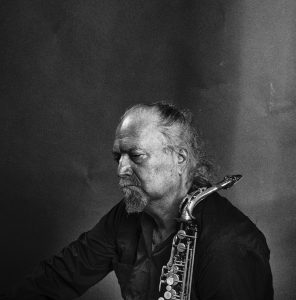
📸 Pelle Seth
Dror Feiler is a composer, saxophone player and a political activist. Born 1951 in Tel Aviv, Israel and living in Sweden since 1973. He plays many varieties of the saxophone: sopranino, soprano, alto, tenor and contrabass, as well Bb clarinet, basset horn, and contrabass clarinet. In addition, he operates computerised sound systems. With his strong sense of vocation, Dror Feiler must rank as one of Sweden’s leading composers and improvisation musicians. Recognition for his accomplishments has grown considerably in recent years, with some of the most important European orchestras, ensembles and festivals commissioning and performing his works: Stockholm New Music, Donaueschingen Musiktage, Hudderseld, Wien Modern, Tectonics Festival. He has performed and recorded with orchestras and ensembles as well as a soloist in Sweden, Russia, Yugoslavia, Serbia, Bosnia, Croatia, United Kingdom, Belgium, Denmark, Finland, Belarus, Lithuania, Latvia, Austria, Switzerland, France, Israel, Palestine, the Netherlands, Hungary, Norway, Germany, Japan, Colombia, Mexico, USA, Brazil, and Argentina. He has composed for Ensemble Modern, Klangforum Wien, Hessischer Rundfunk, Bavarian Radio Symphony, BBC Scottish Symphony, Neo, Krommata Percussion Ensemble, Kwartludium, Ascolta, Contrechamps, Ensemble New Music Tallinn, Vertixsonora, Stavanger symphony orchestra and the Greek Radio orchestra.
The Archipelago of Noise island
The Archipelago of Noise islands is a group of compositions based on the idea of islands of instruments sounds (reed instruments) in a sea of noise in which the abrasive raucousness of the sonic events and the textural complexity paired with melodic fragments are combined into contrasting sound objects in an attempt to challenge how we hear/listen/perceive music/sounds.
In The Archipelago of Noise islands we will be engaged in a struggle to make some sense of what we hear when difficulties to categorize/define the audio stimulus that arise, our attention will be funnelled into the work’s singular moments, and once we realize that each island in The Archipelago of Noise islands is not here to fulfil a macro-structural objective, it becomes something that ends in itself. Instead of singular sonic events existing for the abstract achievements of the whole, the whole is composed to throw us back onto the horns of the singularities. Every singular sonic/textural element/ingredient in the music takes on a specifically meaning, and no clear hierarchy exists between them. Each sonic element in the music is equally close to the centre. Yet equality does not slip into interchangeability, for each ingredient in the music/texture remains painfully particular. Thus we find a possible exemption to Adorno’s claim that the “history of music at least since Haydn is the history of fungibility: that nothing is in-itself and that everything is only in relation to the whole.”
The Archipelago of Noise islands’ sonic elements is sprinting toward each other from opposite far ends of the aural space and will collide in a direct impact. While sound connotes nothing more than the sense-data of hearing, The Archipelago of Noise islands will develop/suggests a disturbance, confusion, and/or interference baldly challenging the conformity of so called “musical quality” and that in sociological terms for me is the essence in the arts.
The Archipelago of Noise islands’ auditory “disturbance” is being generated by sequences and squeals of sounds, by a collision of the now, the memories and the romantic notion of how it was/could/will be, that makes the complexity of sound becomes a form of aural agitation that is affective and transformative and politicizes the aural/textural environment.
https://www.youtube.com/user/drorfeiler/channels
http://www.arte.tv/guide/en/068779-000-A/square-artiste-bargeld?country=SE
https://soundcloud.com/dror-feiler
• Gail Priest •
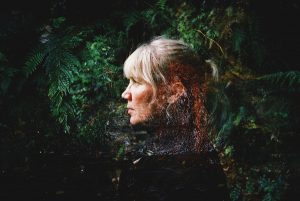
📸 Samuel James
Gail Priest is an Australian artist living on Darug/Gundungurra land in Katoomba. She has a multifaceted practice that explores the aural realm sensorially, materially and conceptually through performance, composition, installation, curation and textual responses. She employs voice, field recording and machine mutterings to enter a liminal zone between abstraction and figuration. The result is a super-saturated ambient baroque mixing ethereal vocals and broken melodies with the occasional nasty noise. She has performed her live compositions and exhibited sound installations in Japan, Hong Kong, Germany, France, Norway, Slovenia, Italy, Iceland and The Netherlands. She has several music releases on her own label, Metal Bitch Recordings, as well as Flaming Pines. She is currently undertaking a PhD exploring our languages of listening.
Performance :
Such is the curious nature of time across the globe, that while for a European it will be late evening, for me this performance will take place as the day begins. It will never cease to amaze me that we can exist, simultaneously, in very different times: me in your future; you in my past; both of us in now. But sound is always about time—a series of indivisible presents that we hear as a flow. Working with field samples, voice and modular synthesisers, the focus of this performance will be on textural and timbral transformation of melodic fragments and entwined drones to heighten our sense of time’s implacable progression. Occasionally I may attempt to regulate time through metric beats—however this will only reinforce the sense of inevitable propulsion: an energetic surrender of the next moment to the next.
Gail Priest · elbejée – loréli (excerpt)
http://www.gailpriest.net
http://gailpriest.bandcamp.com
https://soundcloud.com/gail-priest
• Π Node •
G.O.L.E.M.
G.O.L.E.M. is a live sound construction, resulting from the aggregation of audio streams from several sources. Each participant receives, modifies and reinjects his.her sound vision, deceived by parallel temporalities, in the great common stream. Sensitivities being immediately modified by others, a feedback phenomenon comes into play. A form appears languorously to give birth to a bio-informatics entity releasing a futuristic Out-of-CONTROL.

